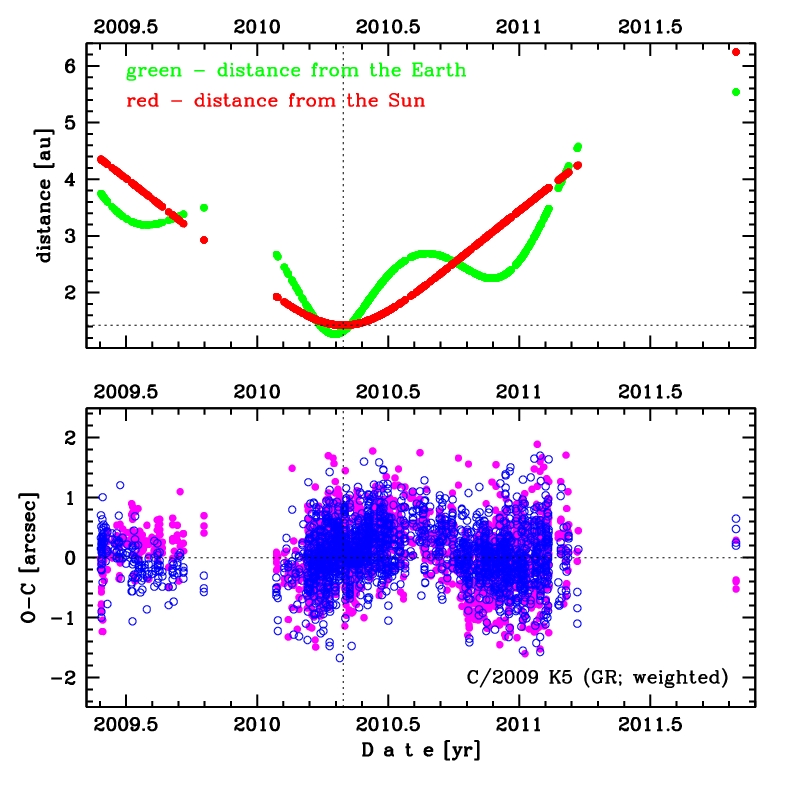| Solar System Dynamics & Planetology Group |
 |
C/2009 K5 McNaught |  |
| Solar System Dynamics & Planetology Group |
 |
C/2009 K5 McNaught |  |

| number of observations | 2539 |
| number of residuals | 4952 |
| data interval | 2009 May 27 — 2011 Oct. 28 |
| rms [arcsec] | 0.47 |
| orbit quality class | 1a+ |
| Epoch (TT) | 20100614.0 | = JD 2455361.5 |
| time of perihelion passage (TT) | 20100430.024135 | ± 0.000009 |
| perihelion distance | 1.42239751 | ± 0.00000009 |
| eccentricity | 1.00083926 | ± 0.00000028 |
| argument of perihelion [deg] | 66.173720 | ± 0.000006 |
| longitude of the ascending node [deg] | 257.856116 | ± 0.000003 |
| inclination [deg] | 103.879415 | ± 0.000005 |
| inverse semimajor axis [10-6 au-1] | -590.03 | ± 0.20 |
| Epoch (TT) | 17101204 | |
| time of perihelion passage (TT) | 20100428.968140 | ± 0.000013 |
| perihelion distance | 1.41933411 | ± 0.00000008 |
| eccentricity | 0.99992985 | ± 0.00000029 |
| argument of perihelion [deg] | 66.205134 | ± 0.000006 |
| longitude of the ascending node [deg] | 257.740137 | ± 0.000003 |
| inclination [deg] | 103.924710 | ± 0.000005 |
| inverse semimajor axis [10-6 au-1] | 49.42 | ± 0.20 |
| Epoch (TT) | 23151014 | |
| time of perihelion passage (TT) | 20100430.285035 | ± 0.000011 |
| perihelion distance | 1.41994001 | ± 0.00000009 |
| eccentricity | 0.99921239 | ± 0.00000029 |
| argument of perihelion [deg] | 66.074823 | ± 0.000006 |
| longitude of the ascending node [deg] | 257.913497 | ± 0.000003 |
| inclination [deg] | 104.020049 | ± 0.000005 |
| inverse semimajor axis [10-6 au-1] | 554.68 | ± 0.20 |
| number of observations | 820 |
| number of residuals | 1559 |
| data interval | 2009 May 27 — 2010 Apr. 29 (pre-perihelion data) |
| rms [arcsec] | 0.33 |
| orbit quality class | 1a |
| Epoch (TT) | 20100614.0 | = JD 2455361.5 |
| time of perihelion passage (TT) | 20100430.024020 | ± 0.000038 |
| perihelion distance | 1.42239454 | ± 0.00000032 |
| eccentricity | 1.00084485 | ± 0.00000080 |
| argument of perihelion [deg] | 66.173708 | ± 0.000028 |
| longitude of the ascending node [deg] | 257.856117 | ± 0.000006 |
| inclination [deg] | 103.879483 | ± 0.000008 |
| inverse semimajor axis [10-6 au-1] | -593.96 | ± 0.56 |
| Epoch (TT) | 17101204 | |
| time of perihelion passage (TT) | 20100428.968071 | ± 0.000031 |
| perihelion distance | 1.41933112 | ± 0.00000030 |
| eccentricity | 0.99993542 | ± 0.00000078 |
| argument of perihelion [deg] | 66.205123 | ± 0.000027 |
| longitude of the ascending node [deg] | 257.740138 | ± 0.000006 |
| inclination [deg] | 103.924779 | ± 0.000007 |
| inverse semimajor axis [10-6 au-1] | 45.50 | ± 0.55 |
| number of observations | 1719 |
| number of residuals | 3357 |
| data interval | 2010 Apr. 30 — 2011 Oct. 28 (post-perihelion data) |
| rms [arcsec] | 0.47 |
| orbit quality class | 1a |
| Epoch (TT) | 20100614.0 | = JD 2455361.5 |
| time of perihelion passage (TT) | 20100430.024291 | ± 0.000023 |
| perihelion distance | 1.42240448 | ± 0.00000056 |
| eccentricity | 1.00084178 | ± 0.00000058 |
| argument of perihelion [deg] | 66.174037 | ± 0.000024 |
| longitude of the ascending node [deg] | 257.856122 | ± 0.000004 |
| inclination [deg] | 103.879388 | ± 0.000007 |
| inverse semimajor axis [10-6 au-1] | -591.80 | ± 0.41 |
| Epoch (TT) | 23150904 | |
| time of perihelion passage (TT) | 20100430.285159 | ± 0.000020 |
| perihelion distance | 1.41994702 | ± 0.00000055 |
| eccentricity | 0.99921490 | ± 0.00000058 |
| argument of perihelion [deg] | 66.075141 | ± 0.000025 |
| longitude of the ascending node [deg] | 257.913504 | ± 0.000004 |
| inclination [deg] | 104.020021 | ± 0.000007 |
| inverse semimajor axis [10-6 au-1] | 552.91 | ± 0.41 |